Do-it-yourself parquet laying technology
Parquet traditionally evokes associations with luxurious palace chambers, chic villas and reputable institutions. This idea has remained since royal times, when the artistic wooden floor was considered a sign of prosperity and showed the high social status of the owners of the house. This parquet is still very popular, despite its high cost in relation to other floor coverings and some difficulty in laying. The lacquered surface of the parquet floor perfectly fits any interior and adds sophistication and gloss to it. In this article, we will take a detailed look at such a process as laying your own flooring with your own hands, and give some tips that allow you to quickly and accurately do all the necessary work yourself without spending additional funds on professionals..
Content
- Is it worth laying parquet
- Parquet laying methods
- General preparation for work
- Preparing the base for installation
Is it worth laying parquet
Many in this flooring are attracted only by its external beauty, and they strive to become its owners, not knowing the pitfalls that they may have to face. Do not forget that parquet is a natural tree that requires special care during operation to maintain its qualities and attractive appearance. This material is very susceptible to major climatic factors. Even the slightest change in humidity and temperature in the room can cause permanent damage to your floor, such as cracks or bloating.
Before deciding on the choice of flooring, think about whether you can maintain the necessary microclimatic conditions for the parquet? It is precisely because of the constant fluctuations in the microclimate that in no case can it be laid in basements and basements, saunas, bathrooms, toilets, winter gardens or as a cover in front of the pool. High humidity in such rooms entails the bending of dies.
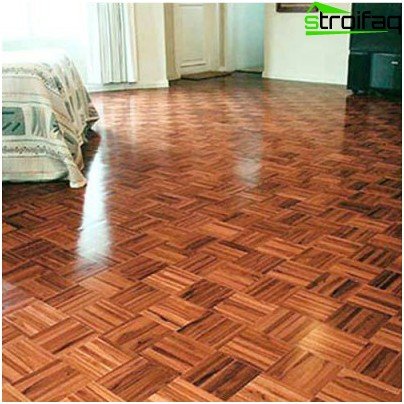
High-quality parquet for many years will delight its owners with its wonderful appearance
Excessive drying of the parquet leads to the same deplorable consequences, therefore, in rooms with insufficient humidity it is best to install special humidifiers.
In principle, all these efforts will not be in vain, because the result will be a huge aesthetic pleasure obtained when looking at a gorgeous floor covering.
Parquet laying methods
There are many ways to lay parquet:
- straight and diagonal deck with offset 1/2, 2/3 or 1/3;
- straight and diagonal herringbone of one, two, three or four boards;
- straight and diagonal squares;
- straight and diagonal braid;
- art masonry.
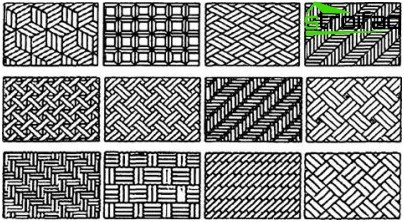
The choice of styling depends on personal preference.
Each of them is good in its own way, and only on the personal preferences of the owner depends on what methods of laying parquet will be chosen for his home. The simplest method is the “deck” or “run”. Parquet strips in this case are strictly parallel to each other. This kind can also be used when dividing the parquet pattern into its component parts..
The floors laid with squares, subject to careful adherence to the technology, have the property of increased resistance to deformation. The herringbone laying is distinguished by the location of the strips: with this method they are located at an angle of 90 ° to each other and at 45 ° to the walls.
General preparation for work
First of all, it is necessary to calculate the flooring and immediately purchase all the necessary material, as well as plywood, which will be needed to level the base. All this must be brought in advance to the room where the laying of piece parquet is planned, and left for a couple of days so that the coating and plywood regain their proper properties.
While the material is “resting”, it is necessary to take care of the tool, so that later on at the most crucial moment, do not run around the shops, wasting precious time and wasting nerve cells. What is needed for laying parquet? Firstly, no good quality construction work is unthinkable without a measuring tool. Should be prepared:
- construction square;
- meter or tape measure;
- construction level (it is better if both types are at hand: both liquid and laser);
- template rail;
- cord.
In addition, you will need a huge assortment of working tools:
- a hammer and a wooden mallet;
- scrap with a claw hammer;
- cycle;
- ticks;
- punch;
- manual hacksaw with several spare blades;
- chisels and chisels of various sizes;
- circular and circular saws;
- Sander;
- drill with punch functions;
- electric plane;
- a small manual grinder (it will certainly be needed in places where a more massive grinder will not reach).
Preparing the base for installation
The quality of the future flooring depends on a properly prepared base surface. If this stage is negligent, it is unlikely that parquet, no matter how beautiful and luxurious it was at the beginning, will delight you with its attractive appearance for a long time.
If the old wooden floor is made of tongue-and-groove boards and is in perfect condition (that is, it does not creak, has no drops and moving places, is firmly fixed to well-dried logs saturated with antiseptic solutions), then the parquet can be laid directly on it. The only thing that needs to be done is to put waterproof plywood on the glue and fix it with self-tapping screws, recessing their heads by at least 5 mm.
If the floor is concrete and its roughness is less than 2 mm for every 2 meters, calculated in any direction, then it is enough to do with a self-leveling mixture, on which sheets of waterproof plywood are also laid.
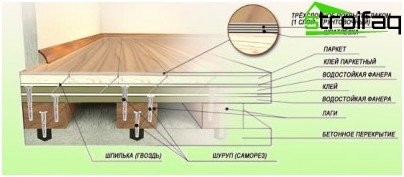
One way to level the surface of the base under the parquet is to install a lag
Otherwise, you will have to resort to more complex methods of preparation, such as:
- laying parquet on the logs;
- laying parquet on concrete screed.
Let’s consider them a little more in detail:
- Laying parquet on the logs. This option is good in that it does not require time spent on drying the base, and also eliminates dirty work. In addition, in the underground space, you can arrange any communication network, or simply increase the heat and sound insulation properties of the floor by laying in the voids of the insulation. Logs are laid perpendicular to the planned direction of the parquet and before that they are processed with special antiseptic solutions. It is better to use adjustable logs that allow you to quickly level the surface of the base by simply tightening the bolts, but if this is not possible, then the usual logs are fastened with screws at a distance of 500 mm from each other, while the heads are also recessed into the tree. After that, the level of the boards is leveled with small wedges and plywood sheets are laid on them..
- Laying parquet on concrete screed. This type of preparation should be chosen if the differences in floor height are more than 2 mm for every 200 mm. To begin with, the concrete base is waterproofed using foil or plastic film, while its edges are displayed on the bottom of the wall. After this, the concrete solution is poured and left to dry for 1-1.5 months. Next, the surface of the base is primed and special glue is applied to it. Now, similarly to the previous methods, you can start laying plywood.
Important: before laying, plywood must be divided into small squares with dimensions of approximately 400×400 mm, and its rows should be offset so that the four corners of the sheets are not connected in any place.
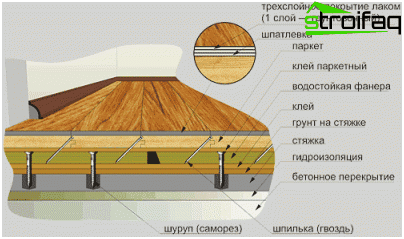
One of the ways to level the base for parquet is screed
Tip: after laying the plywood, it is better to sand it. This will avoid possible differences in height. And also let her “stand” before laying the parquet for 3-4 days.
DIY styling technology
First you need to achieve the necessary microclimate in the room: the temperature should be above + 18 °, and the ambient humidity should be around 60%. Before work, no matter what installation was chosen, it is necessary to lay out the lighthouse snakes, which can be placed both in the two initial rows along the long wall, and along the central axis of the room. For the correct arrangement of rows of lighthouses, a cord is stretched across the room, located above the base surface at a height equal to the thickness of one parquet strip.
It is best to lay the lighthouse snake on hot mastic, which has the property of quickly hardening and does not allow the slats to budge during further work. If the diagonal way of laying parquet is chosen, then rows of beacons should be placed diagonally on the base.
Important: if according to the layout of the lighthouse snake it turns out that in the end an odd number of rows will come out, should it be shifted by? parquet board length.
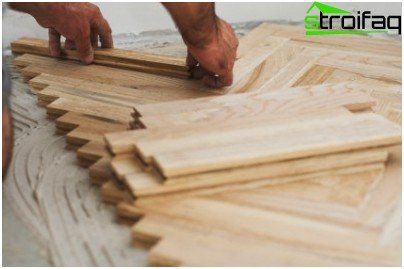
Laying piece parquet: accuracy of joints is ensured by ridges and grooves
The technology of laying parquet depends on the selected material. Most often, parquet floors are recruited from single dies (the so-called piece parquet). Modern planks have ridges and grooves around the perimeter or along the edges, facilitating their connection with each other. Begin work necessarily from the wall farthest from the door so as not to damage the freshly laid coating when exiting.
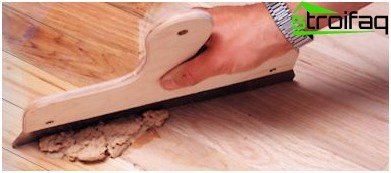
The gaps between the parquet strips must be puttied
A layer of adhesive is applied to the base, and each plank is slightly recessed into this solution, and its canvas is tightly fitted to the already laid rows with a mallet. To prevent displacement during subsequent work, it is additionally fixed with 3 special studs, which are achieved by a punch.
When laying typeset parquet, which is a panel of any shape, assembled from several planks and connected to the front with thick paper, glue is applied to the base and distributed using a notched trowel, and the boards are laid out on top of it with paper. To achieve better adhesion, stacked parquet should be rolled out with a metal roller. After the glue has completely dried, the paper is removed.
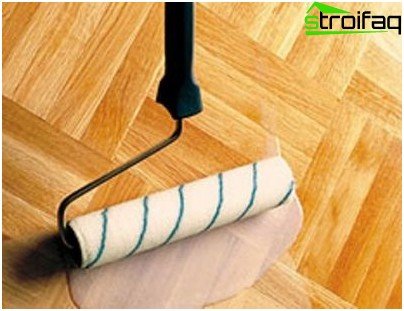
It’s better to varnish the parquet using a special roller
Important: no matter how the floor is laid, deformation gaps of at least 10 mm must be left between it and the walls.
There is another way of laying – artistic, but we will not talk about it in the framework of this article, since its laying requires highly professional wood carving skills and not every master (especially a novice) can do this job efficiently.
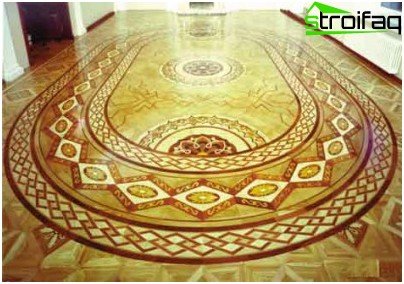
Laying art flooring requires the skills of a woodcarver
After the installation of the floor is completed, its surface must be recycled. Now the base is polished with the smallest sandpaper, putty, primed with special compounds that preserve the color of the tree, and varnished in three layers. Moreover, each layer is necessarily dried and polished (this helps to get rid of small wooden sawdust raised during varnishing).
We hope that the material presented by us has eliminated the latest issues related to laying parquet flooring. Now it all depends only on your patience, because the work will be painstaking and requiring perseverance, but all efforts will be rewarded with a beautiful floor, pleasing you for many years and envy the envy of friends and acquaintances.






